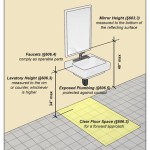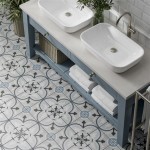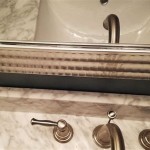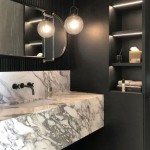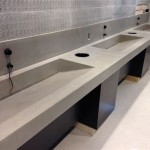How to Cover a Bathroom Sink Countertop
Bathroom sink countertops endure daily wear and tear, susceptibility to staining, and potential damage from water and household products. Covering or resurfacing a bathroom sink countertop offers a cost-effective method to revitalize the space without the expense and disruption of a complete replacement. This article provides a comprehensive guide to various techniques and materials suitable for covering a bathroom sink countertop, ensuring a durable and aesthetically pleasing result.
Understanding the Existing Countertop Material
Before embarking on any countertop covering project, it is crucial to identify the existing material. Common bathroom countertop materials include laminate, tile, solid surface (such as Corian), and natural stone (like granite or marble). The existing material significantly influences the choice of covering method and materials. Laminate countertops, for instance, may be suitable for painting or epoxy coating, while tile countertops might be better addressed with overlaying or resurfacing options. Natural stone, if damaged, may necessitate professional repair or, if significantly deteriorated, complete replacement. Understanding the existing material's properties, such as its porosity, heat resistance, and susceptibility to scratches, will guide the selection of the most appropriate covering solution.
Furthermore, the condition of the existing countertop must be assessed. Cracks, chips, stains, or water damage can affect the adhesion and longevity of the covering material. Minor imperfections can often be addressed with fillers or patching compounds before applying the chosen covering. However, significant damage may require more extensive repairs or even reconsideration of the chosen covering method. A thorough inspection of the countertop's surface allows for informed decision-making and ensures a lasting, professional-looking finish.
Consider the existing countertop's aesthetic properties as well. The color, texture, and overall design can influence the final outcome of the countertop covering. For example, if the existing countertop has a heavily patterned design, choosing a solid color covering may be preferable to avoid clashing. Conversely, if the existing countertop is a neutral color, there is greater flexibility in selecting patterned or textured coverings. Taking these aesthetic considerations into account helps to achieve a cohesive and visually appealing bathroom design.
Exploring Covering Options and Materials
Several options exist for covering a bathroom sink countertop, each with its advantages and disadvantages regarding cost, durability, and ease of installation. Some popular choices include painting, epoxy resin coating, contact paper or vinyl coverings, tile overlay, and concrete overlay. Each method offers a distinct aesthetic and level of protection, catering to various budgets and skill levels.
Painting is a budget-friendly option suitable for laminate or solid surface countertops in good condition. Specialized countertop paints and primers are available, designed to adhere to non-porous surfaces and withstand moisture exposure. Proper preparation, including cleaning, sanding, and priming, is essential for achieving a durable and even finish. While painting offers a quick and affordable solution, it may not be as durable as other covering methods and may require periodic touch-ups.
Epoxy resin coating provides a durable and seamless finish, ideal for creating a modern and high-gloss look. Epoxy resin is a two-part system that, when mixed, creates a self-leveling, hard, and waterproof surface. It can be tinted with various pigments to achieve a desired color or even embedded with decorative elements like glitter or stones. Applying epoxy resin requires careful preparation and precise application techniques to avoid bubbles or unevenness. While epoxy resin coatings offer excellent durability and aesthetic appeal, they can be more expensive and time-consuming to apply than painting.
Contact paper or vinyl coverings offer a cost-effective and relatively easy-to-install option for updating a bathroom sink countertop. These materials are available in a wide range of colors, patterns, and textures, mimicking the look of natural stone, tile, or wood. Contact paper and vinyl coverings are self-adhesive, making them suitable for DIY projects. However, they may not be as durable as other covering methods and can be susceptible to scratching, peeling, or water damage. Proper installation, including smoothing out any air bubbles and sealing the edges, is crucial for achieving a professional-looking and long-lasting result.
Tile overlay involves installing new tiles over the existing countertop surface. This method provides a durable and water-resistant finish and allows for a wide range of design options. Tile overlay requires careful preparation, including leveling the existing surface and applying a bonding agent to ensure proper adhesion. Grouting the tiles correctly is also essential for preventing water penetration and maintaining a clean and attractive look. Tile overlay is a more labor-intensive option than painting or contact paper but offers superior durability and aesthetic appeal.
Concrete overlay involves applying a thin layer of concrete over the existing countertop surface. This method creates a unique and industrial-chic look and provides a durable and heat-resistant finish. Concrete overlay requires specialized tools and techniques, including mixing and applying the concrete and sealing it properly. It can be stained or sealed to achieve various colors and textures. While concrete overlay offers a distinctive and durable option, it may be more challenging to install than other covering methods and may require professional assistance.
Step-by-Step Guide to Countertop Covering
Regardless of the chosen covering method, adhering to a systematic approach is crucial for achieving a successful and long-lasting result. The following steps provide a general guideline for covering a bathroom sink countertop:
1. Preparation: Begin by thoroughly cleaning the existing countertop surface to remove any dirt, grease, or soap scum. Use a degreaser or specialized countertop cleaner for optimal results. Repair any cracks, chips, or imperfections with a suitable filler or patching compound. Sand the surface lightly to create a smooth and even base for the covering material. Protect surrounding areas, such as the sink and walls, with painter's tape and drop cloths.
2. Priming (if applicable): For painting or epoxy resin coatings, apply a primer specifically designed for countertops. The primer promotes adhesion and helps to create a uniform surface. Allow the primer to dry completely according to the manufacturer's instructions.
3. Application: Apply the chosen covering material according to the manufacturer's instructions. For painting, apply multiple thin coats, allowing each coat to dry completely before applying the next. For epoxy resin coatings, mix the resin and hardener carefully and pour it evenly over the countertop surface, using a spreader to ensure uniform coverage. For contact paper or vinyl coverings, carefully peel off the backing and apply the material to the countertop, smoothing out any air bubbles with a squeegee. For tile or concrete overlay, follow the specific installation instructions for the chosen materials.
4. Sealing (If Applicable): Once the covering material has dried or cured completely, apply a sealant to protect the surface from moisture, stains, and scratches. Choose a sealant specifically designed for countertops and follow the manufacturer's instructions for application. Apply multiple coats of sealant for optimal protection, allowing each coat to dry completely before applying the next.
5. Curing: Allow the covered countertop to cure completely before using it. The curing time varies depending on the chosen covering material and sealant. Refer to the manufacturer's instructions for specific curing times.
6. Finishing Touches: Once the countertop has cured, remove the painter's tape and clean any excess sealant or adhesive. Inspect the surface for any imperfections and touch up as needed. Reinstall any fixtures, such as faucets and drains, that were removed during the covering process.
By following these steps and carefully selecting the appropriate covering method and materials, one can successfully transform a dated or damaged bathroom sink countertop into a stylish and functional feature of the bathroom.

Transforming Bathroom Sink Diy With Marble Contact Paper

Paint Bathroom Vanity Countertop Sink So Easy A Piece Of Rainbow

How To Easily Spray Paint Bathroom Countertops My Homier Home

Paint Bathroom Vanity Countertop Sink So Easy A Piece Of Rainbow

How I Transformed My Ugly Ed Countertop For

How To Refinish Bathroom Vanity Top With Diy Resin Thediyplan

Diy Concrete Counter Overlay Vanity Makeover

Diy Easy Bathroom Makeover Transformation Faux Marble Framed Mirror No Paint The Ann

How To Declutter Your Bathroom Sink Counter Make It A Daily Habit

How To Easily Spray Paint Bathroom Countertops My Homier Home
